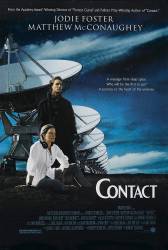Visible crew/equipment: During the scene when Ellie has discovered the Signal, and is in the control room with the guys, she turns to one of them and says "Make me a liar". Right when she turns, you can see some bright, smaller, roundish white lights reflected in her eyeglass lens. These are probably camera lights, as their appearance wouldn't match the computer screens or natural lighting in the room.
Continuity mistake: When they realize the signal's counting prime numbers, watch the man in the red shirt behind Ellie when 11's being counted off. He's counting on his fingers, fills up his right hand, and moves to his left. The angle then changes to a closer shot, and his left hand is now curled up, with no numbers counted off on it at all, and he continues on his right.
Plot hole: After Ellie makes her journey which she firmly believes happened she is questioned as everyone else watched the pod drop straight down into the water. But no mention is made of the chair that is violently shaken loose during her 18 hour journey. If that were to have happened in the split-second the pod fell through she would have been badly injured more than just a bump on the head.
Factual error: Hadden tells Ellie that the zero gravity and low oxygen environment aboard Mir is slowing the progress of his cancer. Quite apart from this being medically absurd, he isn't in a low oxygen environment - Mir's atmosphere was identical to that on Earth, and he has a nasal canula fitted - he is in a high oxygen environment, not a low one. Zero gravity? It puts cells under enormous stress causing them to age prematurely, accelerating tumour growth, not slowing it.
Suggested correction: A zero gravity environment can have drastic effects on the Human body, such as decrease in body mass and less muscle strength, to name a couple. It also causes the body to lose a great deal of fluid which would normally be forced down into the abdomen and legs by gravity. (This is why Shuttle astronauts have to force-drink mass fluids just prior to re-entry, to avoid light-headedness from the pronounced lack of fluid their bodies are still experiencing while re-entering a gravity atmosphere). It's possible theoretically that zero-gravity could also have an effect on aggressive cancer, and the entire premise of this movie is theoretical. Also, the nasal line could be to make it easier for Hadden to breathe in his weakened condition, adding some oxygen, but at the same time he was still breathing in the overall atmosphere inside the Space Station as the line wouldn't completely block his nose and mouth.
The atmosphere on Mir was identical to that on Earth - 78% nitrogen, 21% oxygen with an air pressure of 101.3 kPa. If Hayden is breathing that, augmented by a nasal cannula, he is in an oxygen-enhanced atmosphere. As for low gravity slowing the growth of a cancerous tumour, the weak pull of microgravity places cells under extreme stress, causing them to age more rapidly. This accelerates the growth of a cancerous tumour.
Factual error: The scene where Ellie and Palmer are looking at the stars next to the Arecibo observatory dish, they are looking at the constellation Cassiopeia. This constellation is visible to the North. However, judging from the parts of the antenna structure visible in the background, they are actually looking South. The suspended walkway/cable raceway connecting the control room and the antenna structure visible in this shot is on the North side of the dish. In real life, the control room and observation areas are on the North side of the dish. It is also not clear what time of the year this was but Cassiopeia is not visible from Puerto Rico during part of the year due to its low elevation above the horizon.
Factual error: Hokkaido island geography shows a relatively smooth coastline. The location of the second machine cannot be natural, but must have been added post production.
Continuity mistake: Ellie tells Palmer her father died when she was nine years old. Later, when Mr. Hadden goes over her life history to impress her, the dates of her birth and her father's death indicate she was ten years old when he died.
Character mistake: When they first receive the alien signal, they decode it and play it as a TV signal which shows Hitler speaking at the opening of the 1936 Summer Olympics in Berlin. Kent translates what Hitler is saying as "I declare the Games in Berlin, at the celebration of the first Olympics of the New Era, as opened." Hitler actually says "the *eleventh* Olympics of the New Era." The "New Era" doesn't refer to some Nazi concept, it's used to separate the modern Olympics from the ancient ones in Greece.
Continuity mistake: While receiving the prime number pulses, there is a discontinuity between the pulse sequence being received and what is displayed on the monitors. As the sequence for "seven" starts (right after Ellie tells Fish to start counting the pulses), the camera switches to a computer monitor display which indicates the sequence for "seven" has already completed, and is logging the pulses of the sequence for "eleven".
Continuity mistake: When talking with Ellie on his plane Haddon's hand alternates to being on Ellie's shoulder in shots facing him to not touching her in shots behind him.





